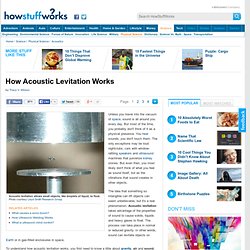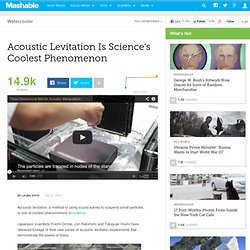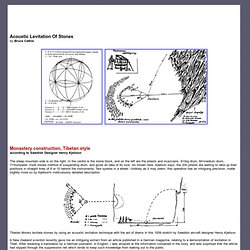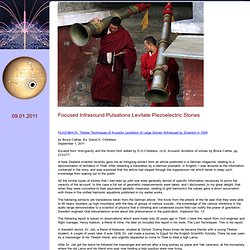

Acoustic levitation. Acoustic levitation (also: Acoustophoresis) is a method for suspending matter in a medium by using acoustic radiation pressure from intense sound waves in the medium.

Acoustic levitation is possible because of the non-linear effects of intense sound waves.[1] Some methods can levitate objects without creating sound heard by the human ear such as the one demonstrated at Otsuka Lab,[2] while others produce some audible sound. There are many ways of creating this effect, from creating a wave underneath the object and reflecting it back to its source, to using an acrylic glass tank to create a large acoustic field. Acoustic levitation is usually used for containerless processing which has become more important of late due to the small size and resistance of microchips and other such things in industry. Containerless processing may also be used for applications requiring very-high-purity materials or chemical reactions too rigorous to happen in a container. See also[edit] References[edit] Argonne National Laboratory. How Acoustic Levitation Works"
Unless you travel into the vacuum of space, sound is all around you every day.

But most of the time, you probably don't think of it as a physical presence. You hear sounds; you don't touch them. The only exceptions may be loud nightclubs, cars with window-rattling speakers and ultrasound machines that pulverize kidney stones. But even then, you most likely don't think of what you feel as sound itself, but as the vibrations that sound creates in other objects. The idea that something so intangible can lift objects can seem unbelievable, but it's a real phenomenon. To understand how acoustic levitation works, you first need to know a little about gravity, air and sound. Second, air is a fluid that behaves essentially the same way liquids do. Third, sound is a vibration that travels through a medium, like a gas, a liquid or a solid object. The sound wave travels as the moving molecules push and pull the molecules around them. Click the arrow to move on to the next slide. Acoustic Levitation Is Science's Coolest Phenomenon.
Acoustic levitation, a method of using sound waves to suspend small particles, is one of coolest phenomenons in science.

Japanese scientists Yoichi Ochiai, Jun Rekimoto and Takayuki Hoshi have released footage of their new series of acoustic levitation experiments that demonstrate the power of noise. Image: Mashable The clip provides a quick and simple overview of the team's work before getting into some mind-bending levitation experiments with small items like nails, bolts, wood pieces and even drops of liquid. Acoustic Levitation: Scientists Use Sound Make Objects Levitate. Scientists have developed a sound generator so powerful its shock waves can stun, and even kill people.

Another group of researchers have developed another unusual application for sound: a method of "acoustic levitation" that could help maintain colonies on Mars or the moon by using high-pitched sound waves to remove alien dust. Wired explains, Blasting a high-pitched noise from a tweeter into a pipe that focuses the sound waves can create enough pressure to lift troublesome alien dust off surfaces, according to a study published January in the Journal of the Acoustical Society of America.
Extra-terrestrial missions have been plagued by dust and debris, which cling to rovers and astronauts because lunar and Martian environments lack the Earth's water or atmosphere that can displace the particles. According to Wired, Acoustic Levitation Of Stones. Acoustic Levitation Of Stones by Bruce Cathie Monastery construction, Tibetan style according to Swedish Designer Henry Kjellson The steep mountain side is on the right.

In the centre is the stone block, and on the left are the priests and musicians. Tibetan Monks levitate stones by using an acoustic levitation technique with the aid of drams in this 1939 sketch by Swedish aircraft designer Henry Kjellson. A New Zealand scientist recently gave me an intriguing extract from an article published in a German magazine, relating to a demonstration of levitation in Tibet. All the similar types of stories that I had read up until now were generally devoid of specific information necessary to prove the veracity of the account. The following report is based on observations which were made only 20 years ago in Tibet. A Swedish doctor, Dr Jarl, a friend of Kjelsons, studied at Oxford. Resonance in the Tibetan Acoustic Levitation Traditions. Focused Infrasound Pulsations Levitate Piezoelectric Stones FLASHBACK: Tibetan Techniques of Acoustic Levitation of Large Stones Witnessed by Scientist in 1939 by Bruce Cathie, Ed.

David H. Childress September 1, 2011 Excerpt from 'Anti-gravity and the World Grid' edited by D.H.Childress, ch.8, Acoustic levitation of stones by Bruce Cathie, pp. 213-217: Acoustic levitation. Sound Waves Make Liquids Levitate, Develop Better Drugs. Liquids can levitate, thanks to the magic of science.

Researchers at Argonne National Laboratory have designed a device, fittingly called acoustic levitator, that uses two speakers that generate sound waves in order to make small droplets of liquids float. The high-power sounds waves, which are imperceptible to the human ear, interfere with each other and create what's called a "standing wave," a place where liquids effectively get trapped and stand still. Researchers hope this experiment will help develop amorphous drugs. These type of drugs require a smaller dose to reach the desired effects, and thus have gentler side effects. Normally, however, drugs have a crystalline structure because it's harder to produce amorphous ones.
SEE ALSO: Levitating Sculpture Plays a Hauting Hymn [VIDEO] Check out the video above to see how droplets of liquids get suspended in the air. Sound waves have brought us closer to a levitation machine. Lévitation acoustique.